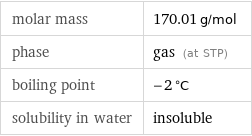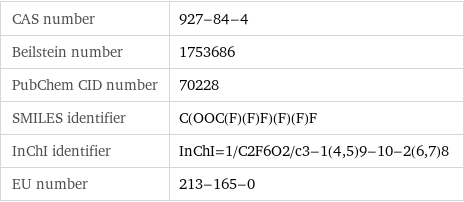Input interpretation

bis(trifluoromethyl)peroxide
Chemical names and formulas

formula | C_2F_6O_2 name | bis(trifluoromethyl)peroxide IUPAC name | trifluoro-(trifluoromethylperoxy)methane alternate names | di(trifluoromethyl)peroxide | hexafluorodimethyl peroxide | trifluoromethyl peroxide mass fractions | C (carbon) 14.1% | F (fluorine) 67% | O (oxygen) 18.8%
Lewis structure

Draw the Lewis structure of bis(trifluoromethyl)peroxide. Start by drawing the overall structure of the molecule: Count the total valence electrons of the carbon (n_C, val = 4), fluorine (n_F, val = 7), and oxygen (n_O, val = 6) atoms: 2 n_C, val + 6 n_F, val + 2 n_O, val = 62 Calculate the number of electrons needed to completely fill the valence shells for carbon (n_C, full = 8), fluorine (n_F, full = 8), and oxygen (n_O, full = 8): 2 n_C, full + 6 n_F, full + 2 n_O, full = 80 Subtracting these two numbers shows that 80 - 62 = 18 bonding electrons are needed. Each bond has two electrons, so the above diagram has all the necessary bonds. There are 9 bonds and hence 18 bonding electrons in the diagram. Lastly, fill in the remaining unbonded electrons on each atom. In total, there remain 62 - 18 = 44 electrons left to draw: Answer: | |
3D structure

3D structure
Basic properties

molar mass | 170.01 g/mol phase | gas (at STP) boiling point | -2 °C solubility in water | insoluble
Units

Chemical identifiers

CAS number | 927-84-4 Beilstein number | 1753686 PubChem CID number | 70228 SMILES identifier | C(OOC(F)(F)F)(F)(F)F InChI identifier | InChI=1/C2F6O2/c3-1(4, 5)9-10-2(6, 7)8 EU number | 213-165-0
NFPA label

NFPA label

NFPA hazards | oxidizing agent